1 The emergence of ‘labour’: Human subsistence through to the Scientific Revolution
This chapter presents a brief history of human labour beginning with early human subsistence models and concluding with western concepts of ‘labour’ as emerging during the Scientific Revolution.
Learning Objectives
By the end of this chapter, we will have explored:
- The transition of human activity from subsistence living through to the division of a society’s tasks into different roles that, over time, become increasingly specialised and come to be undertaken by specific community members as their ‘work’.
- The links between an emerging scientific paradigm and its use in the judgement of some humans as ‘lesser’ than others, leading to the devaluation of their labour as a justification for slavery.
For most of human history, people have not worked – they have simply laboured to survive. In early communities, humans hunted and gathered to ensure their daily survival. As agricultural techniques developed in the Neolithic Era (5000–3000BC), some people were freed up from subsistence food production which enabled them to develop role specialisations (Baysal, 2013; Violatti, 2018). As communities divided up the work, people took on different tasks, and even some free time was eked out. In Neolithic Greece, beads for decorative necklaces demonstrate a specialised craft activity that emerged when access to raw materials combined with leisure time (Perlès, 2021). Come the end of the Neolithic Era in ancient Egypt, the division of roles was so sophisticated that social hierarchies defined everyone’s place in society determining the labour they were eligible to perform and, consequently, the lifestyle they could aspire to (see Figure 1.1).
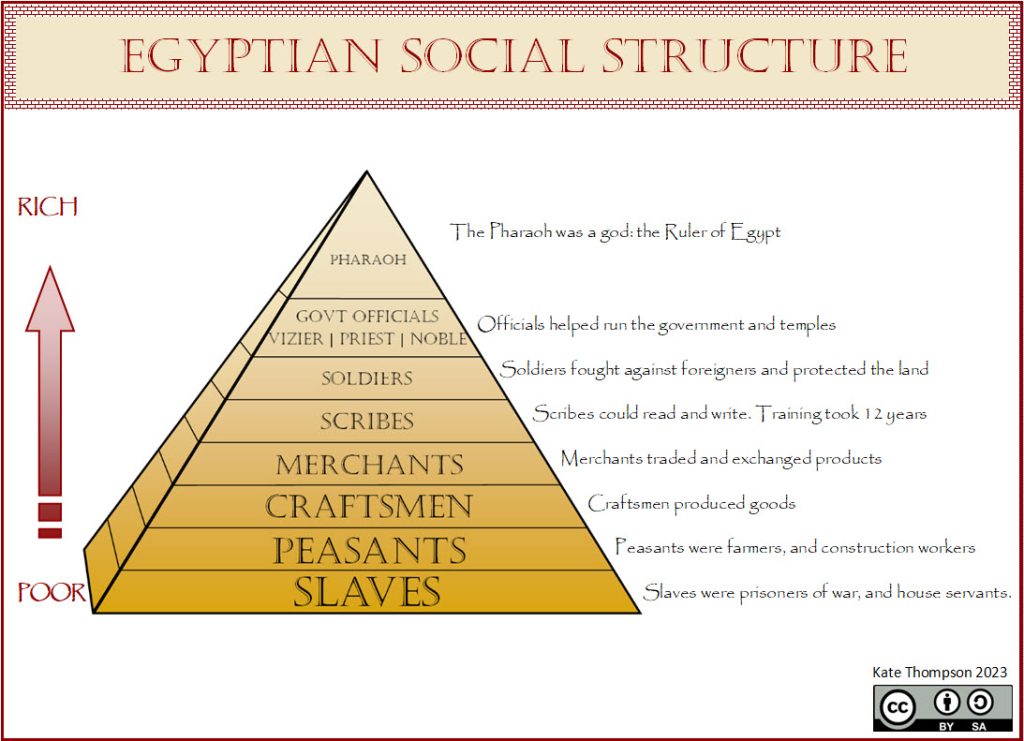
Figure 1.1: Egyptian social structure
Source: Kate Thompson, CC BY-SA
The hierarchical centralisation of power in societies led to the rise of conquests by historical figures including Alexander the Great (Macedonian, b. 356BC, d. 323BC) who conquered Greece then Egypt through to modern day India (Wasson, 2016), Caesar Augustus (Roman, b. 63BC, d. 14AD) who expanded the Roman Empire from the Italian peninsula to Egypt, Central Europe and parts of the Middle East (Appleton, 2022) and Genghis Khan (Mongolian, b. 1162AD, d. 1227AD) who aspired to control the ‘silk road’ trading route between Asia and Europe (Appleton & Willis, 2022). Taking command of other societies enabled the conquerors to seize both natural resources and the labour of the conquered peoples (Spoden, 2019).
Indeed, slavery was pivotal to the expansion of the Roman Empire creating “one of the few ‘genuine slave societies’ in the western experience” (Harper, 2011, p. 3). While war led to some direct enslavement of the enemy, it mainly created conditions that stimulated the slave trade such as orphaned children, who could be easily enslaved, and cashed up ‘victors’ (wealthy from the spoils of war) who could afford to buy slaves at markets (Wickham, 2014). Harper concludes that, at the peak between 275 – 425AD, “the top 1.356 percent of Roman society thus owned the bottom 5% of Roman society” (Harper, 2011, p. 59–60) and slaves comprised 10% of the Roman Empire’s population (Harper, 2011). This represented a considerable amount of unpaid slave labour, with slaves in rural settings engaged in agricultural production and mining while those in urban areas were household servants, in public service and craft production (Hunt, 2010). Perhaps surprising is that there some were highly educated, for example, being a physician (doctor) was predominantly an occupation undertaken by slaves in Roman times (Mohler, 1940).
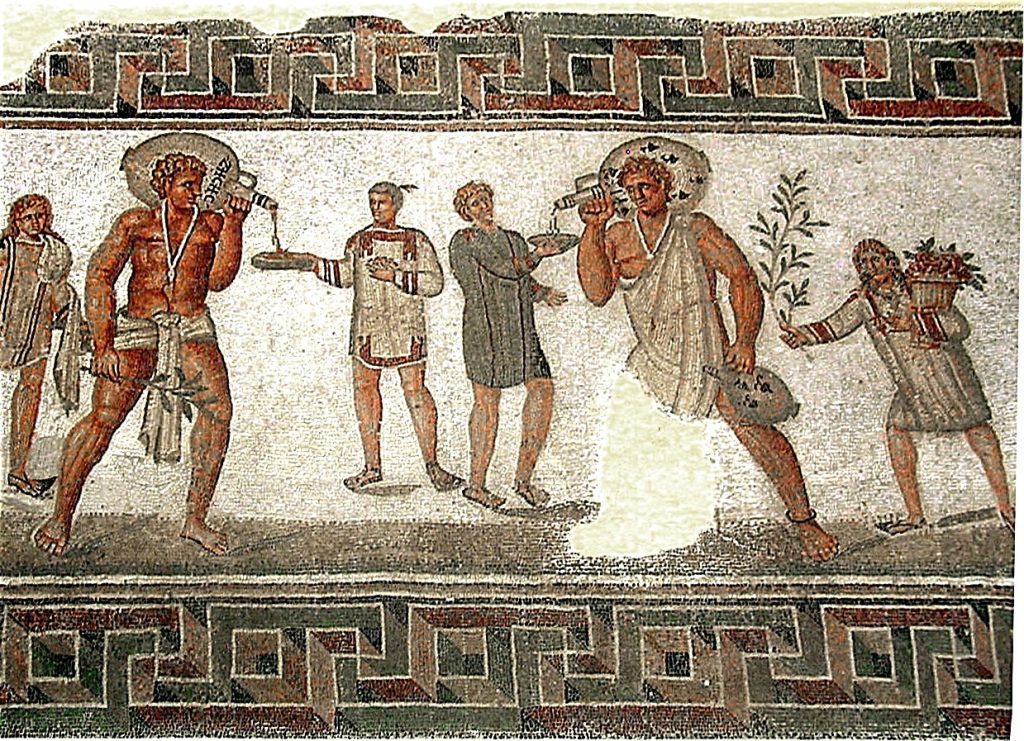
Figure 1.2: A tile mosaic depicting two slaves serving wine in the 2nd century AD at Roman settlement Dougga (modern day Tunisia)
Source: “Mosaic of cupbears” by Pascal Radigue, Wikimedia Commons, CC BY 3.0
Modifications to perspective, framing and lightening by Habib Mhenni.
After the collapse of the Roman Empire in Europe, came the Middle Ages (circa 500–1500AD) where social status, and work roles, were organised according to a Medieval feudal system (see Figure 1.3). This ranked King and Church at the top and cascaded through levels of wealth down to independent peasants and serfs (forced labourers) at the bottom (Encyclopaedia Britannica, 2023a).
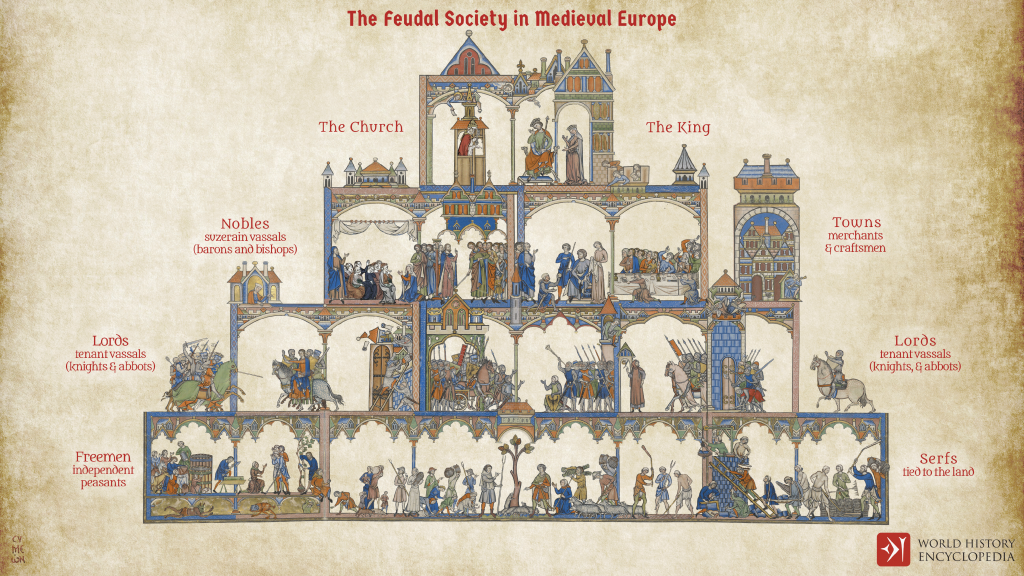
Figure 1.3: The Feudal Society of Medieval Europe
Source: “The Feudal Society in Medieval Europe” by Simeon Netchev, World History Encyclopedia, CC BY-SA
By the time of the Elizabethan period (1558–1603), British social structures had shifted towards a more simplified class system with the nobility, the gentry, the yeomanry and the poor. The nobility held power, while the gentry’s status was achieved through properties and fortunes; these two groups did not work for a living. The yeomanry strived to improve their lives through improving their lands to generate the necessary savings to buffer them from poverty in difficult times. The poor worked for others, according to their ability and opportunities, but they struggled to secure food and a place to live (Historical Association, n.d.).
Europe’s noble class, similar to previous historical empires, came to increase their power and wealth through territorial expansion (Spoden, 2019). The Age of Discovery (1450–1550) began with Portuguese exploration of Africa. Later Christopher Columbus, who was exploring on behalf of the Spanish, reached the Americas. The Dutch, the French and the English were also all striving to establish trade, secure new resources and, over time, colonised new lands (Brown Mitchell, 2023). In Britain, for example, the “transformation of the English mercantile economy from its previous dependence upon a single commodity into a diversified entrepôt [port] that transshipped dozens of domestic and colonial products was one of the most significant developments of the century” (Encyclopaedia Britannica, 2023b, para 3). However the newfound wealth came at a cost to some. In conquering the Americas during the 16th Century, the Spanish “forced the indigenous people to work in exchange for ‘protection’. The system of forced labour used by the Spanish in the New World decimated the native population…The Spanish and Portuguese authorities encouraged their traders to use Africans for this work instead” (Mohamud & Whitburn, 2018, para. 4). The British followed suit, buying African slaves from Dutch traders and relocating them to their British colonies (in the Caribbean and America) to work on plantations (Mohamud & Whitburn, 2018).
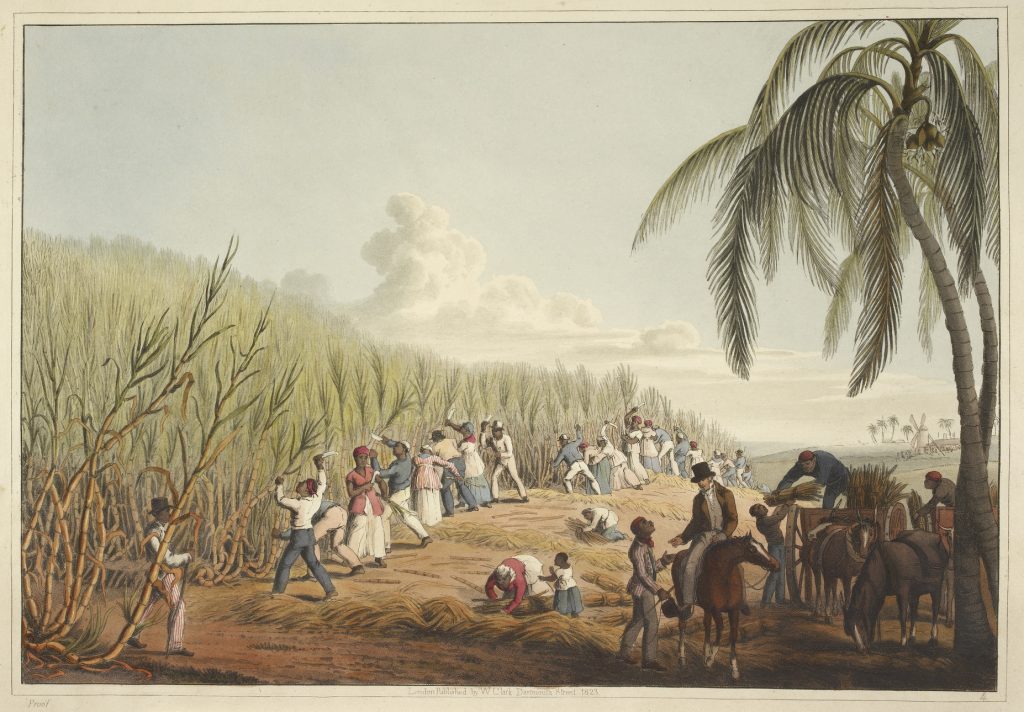
Figure 1.4: Slaves cut sugar cane in 1823 for the British Empire on the Island of Antigua (Caribbean)
Source: “Ten Views in the Island of Antigua” by William Clark, British Library on Flickr, Public Domain
Interestingly then, European (Western) efforts to explore, claim and colonise coincided with the Scientific Revolution (1500–1700): “Since its birth around the same time as Europeans began conquering other parts of the world, modern Western science was inextricably entangled with colonisation, especially British imperialism.” (Deb Roy, 2018, para. 5) Early in the Scientific Revolution, Sir Francis Bacon (b. 1561, d. 1626) challenged the traditional ways of ‘knowing’ established in ancient Greece (Sylvester, 1994) by promoting empiricism: “A conclusion or piece of evidence derived from observation, investigation, or experiment; an empirical result or generalization” (Oxford English Dictionary, 2022, para. 2) thereby forming the foundations of modern experimental science.
Come the 1700s, natural science had become a popular pastime of the educated British leisure class (gentry). “’Natural philosophy’ was mainly an amateur activity pursued by English gentlemen during their leisure.” (Sylvester, 1994, p. 1) Some, such as Sir Joseph Banks (see Box 1.1), paid to join large explorative expeditions and use scientific principles to understand, via observation, the plants, animals and peoples of the places they ‘discovered’ (Ministry for Culture and Heritage, 2023). Lawrence (2015, para. 2) reflects:
In the eighteenth century many famous expeditions were despatched from Europe. These were often explicitly colonising enterprises, particularly involving the annexation of various regions in South America, India, Australasia and the Pacific Ocean. Historians now acknowledge that these expeditions mostly appropriated local objects and information in order to enhance Western knowledge.
The geo-political expansion of the British Empire was a source of opportunity for gentlemen to engage in natural science which, Lawrence (2015) suggests, was principally the acquisition and subsequent display of curiosities.
Box 1.1: Joseph Banks the botanist onboard Captain Cook’s Endeavour voyage
Joseph Banks came from that enviable class the landed gentry; close enough to the land to draw common sense from it, and with enough of it to draw from it also a handsome revenue; with brains enough, indeed, unlike some country gentry, to repay education, and with wealth more than enough to allow of a town as well as country existence, and of a standing in society which no mere rural squire could claim. (Beaglehole, 1962, p. 3)
As natural science was a relatively new field of study, Joseph Banks learned Botany at Eton by paying local women to teach him about the plants they gathered for herbal medicines. At Oxford, he wished to continue his study of plants so paid one of Cambridge University’s botanists to teach him (Te Papa, 1998). His most famous expedition was on the Endeavour with Captain Cook exploring Tahiti, Huahine, Borabora, Raiatea, New Zealand and Australia (Beaglehole, 1974). “The Endeavour voyage was his second major field trip…It was estimated to have cost him about £10,000 (worth more than NZ$1.5 million).” (Te Papa, 1998, para. 4). According to ship records, Banks funded fellow travellers including naturalist Daniel Solander, a secretary, two artists and four servants (Captain Cook Society, 2023). Beaglehole (1962) points out, “It must have been a truly exciting experience for the botanists to find themselves in a land where every species of plant was new to them”. Banks’ silver fern specimen from the Endeavour voyage (Figure 1.5) is part of Te Papa’s (Museum of New Zealand) collection.
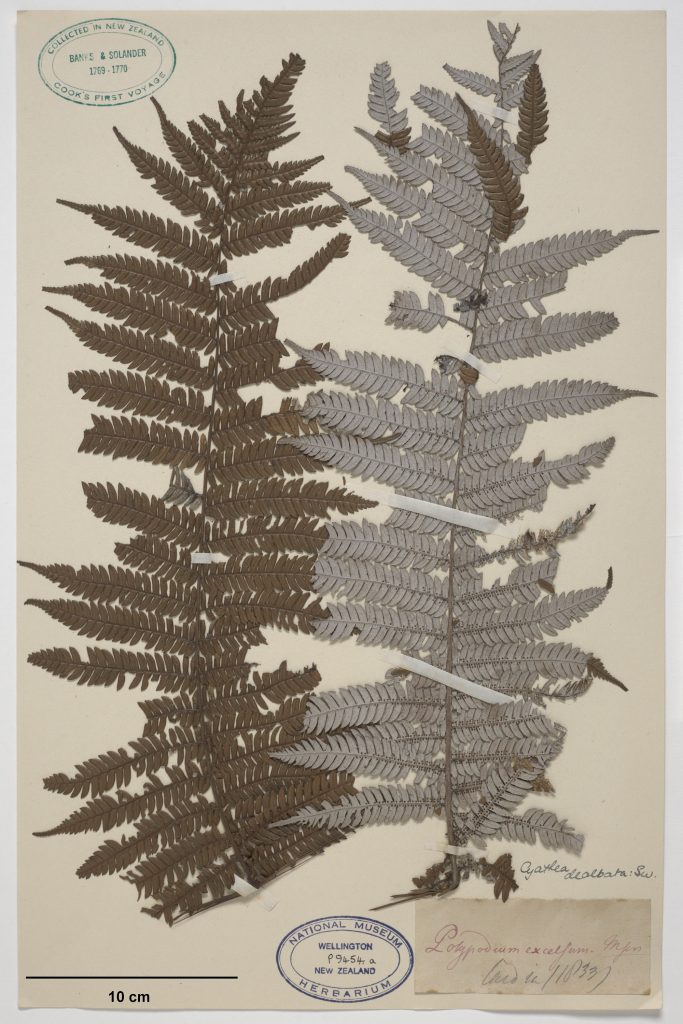
Figure 1.5: A Silver Fern specimen collected by Sir Joseph Banks and Dr Daniel Solander in Aotearoa / New Zealand on the 5th November 1769
Source: Museum of New Zealand Te Papa Tongarewa (P009454/A), CC BY 4.0
However, there was a dark side to this natural science. The artists onboard the Endeavour did not simply sketch the plants but, see Figure 1.6, also the peoples of these then remote places. “The drawings and paintings made by the artists during the expeditions formed the basis for dozens of artworks, which brought to life areas of the world that had previously been little known the Europeans.” (Anderson, 2017, para. 1)
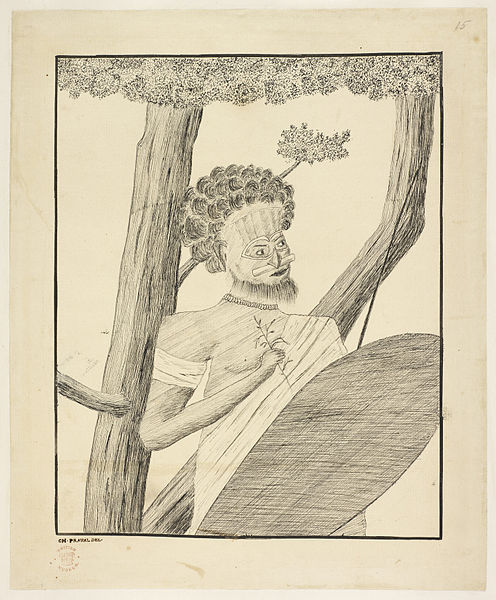
Figure 1.6: A portrait of an Australian Aborigine [sic] circa December 1770 – January 1771
Source: “Drawings illustrative of Captain Cook’s First Voyage” by Charles Praval, British Library on Flickr, Public Domain
This image depicting an Indigenous Australian, and other similar drawings, would go on exhibition for the British elite and were then made more widely available via their reproduction in publications including The Gentleman‘s Magazine. They came to shape British perceptions of the peoples encountered (Anderson, 2017).
Activity 1.1
The Grand Tour was “a practice that introduced Englishmen, Germans, Scandinavians, and also Americans, to the art and culture of France and Italy…possible only for a priviledged class—the same that produced gentlemen scientists, authors, antiquaries, and patrons for the arts.” (Sorabella, 2003, para. 1)
This ‘tour’ of European cultural highlights occurred from the late sixteenth century for over three hundred years. Visiting Italian cities, with their roman statues and architecture, had a lasting impact on the socially powerful young men of the Grand Tour and thus influenced many aspects of British life at that time (Sorabella, 2003).
Consider then how an artist’s worldview, strongly influenced by their Grand Tour and ancient Rome, might influence how they depict the peoples they encountered on their colonial expeditions.
When British slavery peaked between 1660 and 1838 (Carey, 2016), the entire British society benefited from slave labour. “The British state, and the nation as a whole, reaped the benefits from the duties collected on slave-produced colonial goods…The consumption of cheap slave-produced colonial commodities was widespread” (Donington et al, 2016, p 1–2) Interestingly, it was these duties (taxes) that led to the American Revolution against the British (1765–1783), with those living in the British Americas perceiving the taxing as signalling the beginning of efforts towards their entire enslavement (Rothschild, 2018).
Past influencing the present
Like the sugar being consumed in English tea rooms – our contemporary society also benefits from slave labour. Modern slavery describes the ways in today’s economy that labour or services are being extracted from people, including children, unwillingly and without appropriate compensation. In 2021, World Vision reported that New Zealanders unknowingly spend approximately NZ$34 dollars a week on products ‘implicated’ in modern slavery (World Vision, 2021).

Figure 1.7: Modern slaves in Bali, Indonesia
Source: Untitled by Nick Agus Arya, Unsplash, Unsplash licence
Once successfully independent of Britain, citizens of the United States constantly debated the morality of slave labour in their society (Conlin, 2015). The Declaration of Independence, signed by the original 13 states on the 4th July 1776, stated, “all men are created equal, that they are endowed by their Creator with certain unalienable Rights, that among these are Life, Liberty and the pursuit of Happiness” (Jefferson, 1776, para. 2). In 1861, a tipping point was reached between northern states that had abolished slavery in the early 1800s and the southern states that sought to retain it; the American Civil war (1861–1865) was based on the premise of abolishing slavery in the USA (Conlin, 2015). Abraham Lincoln (16th President of the United States 1861–1865) supported the emancipation (liberation) of America’s slaves and the abolishment of slavery via his Emancipation Proclamation during the American Civil War in 1863 (see Figure 1.8). The emancipation of slaves and the implications for labour markets conditions during the American Industrial Revolution are a focus of Chapter 3.
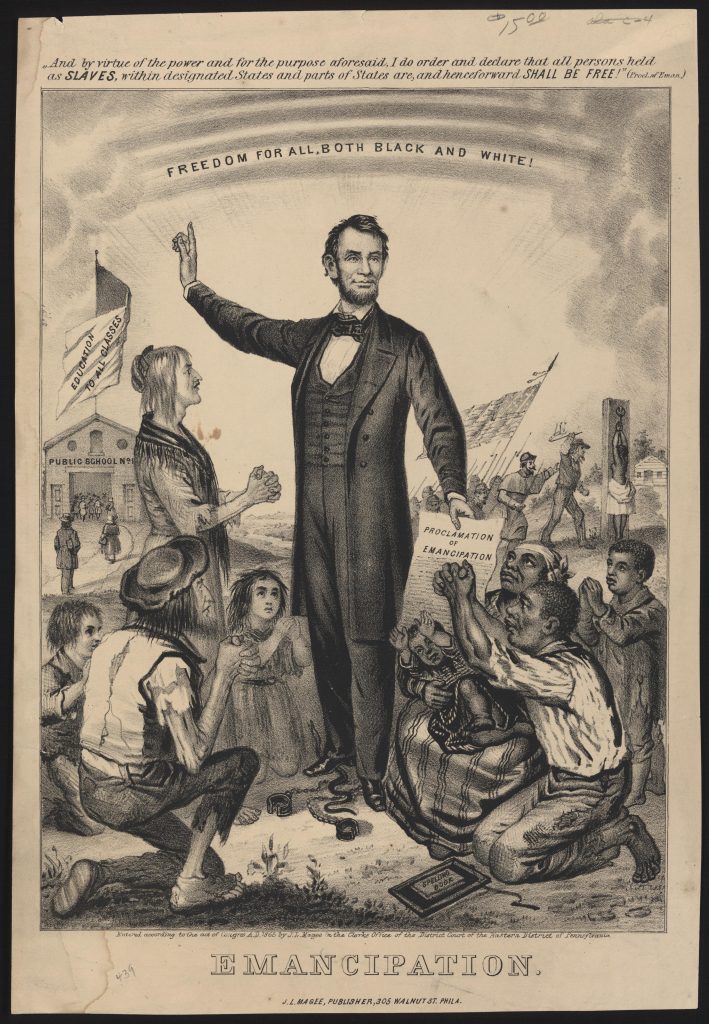
Figure 1.8: An artistic depiction of Abraham Lincoln delivering his 1863 Emancipation Proclamation.
Source: “Emancipation” by J. L. Magee Publisher, Library of Congress, Public Domain
From this chapter, we have learned that human survival tasks evolved into specialised roles undertaken by, and often limited to, particular community members as their work. As societies expanded, there was a desire to take over other human settlements and harness their peoples in the further expansion of the conqueror’s empire. With this emerged slavery; sometimes as ownership of the slave or, at least, as forced labour.
Past influencing the present
While slavery has been recorded far back in history, the intertwined histories of colonisation with the Scientific Revolution in the 1700–1800s is critical to understanding contemporary cultural and diversity perspectives in Human Resource (HR) management in workplaces today.
Linda Tuhiwai Smith, in Decolonizing Methodologies: Research and Indigenous Peoples, writes:
The ways in which scientific research is implicated in the worst excesses of colonialism remains a powerful remembered history for many of the world’s colonized peoples. It is a history that still offends the deepest sense of our humanity. Just knowing someone measured our ‘faculties’ by filling the skulls of our ancestors with millet seeds and compared the amount of millet seed to the capacity for mental thought offences our sense of who and what we are. (2021, p. 1)
We can now see how science and colonisation frame slavery as:
In the 1700s and early 1800s, scientists in Europe and the Americas studied “race science” —the idea that humankind is divided into separate and unequal races. They tried to explain the contradiction between the belief in human equality expressed during the American and French Revolutions and the emergence of slavery in the United States and several European countries. (Facing History & Ourselves, 2017, para. 1)
Today HR managers are striving to address the legacy of colonisation in HR and Employment Relations practices through initiatives such as equitable recruitment strategies (anti-discrimination) through to proactive strategies to attract, and support, indigenous employees as they overcome years of inter-generational discrimination based on ‘principles’ of natural science that justified their slavery and de-valued their labour.
Chapter 2 will now examine how, parallel to the natural sciences, the scientific fields of physics and mechanics led to machines and new industries during the Industrial Revolution creating the conditions that founded workplace, health and safety from within the unionised ‘labour’ rights movement.
William McNeill explains that the "west" and "western" have different interpretations across history and dependent on the particular context: " 'the West' in the sense of Western civilization. The first and most obvious point to make is that the meaning of the West is a function of who is using the word. Those who feel themselves to be part of the West-who think of the West as “we’‘-will surely have flattering things to say about their civilization. Those who think of the West as the “other” are likely to define it in less flattering terms. The basic meaning of the word is “where the sun sets”-one of the cardinal directions” (1997, p. 513).
However, at this time in history, western "encompassed the Atlantic littoral of Europe (the British Isles, Scandinavia, the Low Countries, France, and Iberia) plus America. In time, it came to encompass Australia, New Zealand, and all other European overseas settlements, The West, therefore, could be imagined as a civilization independent of locale" (McNeill 1997, p. 513 - 514).
Work is "the activities and labour necessary to the survival of society" (Encylopaedia Britannica, 2018, para. 1).
Labour "means any valuable service rendered by a human agent in the production of wealth, other than accumulating and providing capital or assuming the risks that are a normal part of business undertakings" (Encyclopedia Britannica, 2022, para. 1).
Slavery is “a form of dependent labour performed by a nonfamily member. The slave was deprived of personal liberty and the right to move about geographically" (Encylopaedia Britannica, 2022, para. 1).
A slave is a " person who has the (legal) status of being the property of another, has no personal freedom or rights, and is used as forced labour or as an unpaid servant; an enslaved person" (Oxford English Dictionary, 2022, para. 1).
Slave labour is “labour performed involuntarily and under duress, usually by relatively large groups of people” (Encylopaedia Britannica, 2022, para. 1).
“Middle Ages, the period in European history from the collapse of the Roman civilisation in the 5th century to the period of Renaissance (variously interpreted as beginning in the 13th, 14th or 15th century, depending on the region of Europe and other factors)” (Encyclopaedia Britannica 2023, para 1).
"Forced labour differs from slavery in that it involves not the ownership of one person by another but rather merely the forced exploitation of that person’s labour" (Encyclopedia Britannica, 2023, para. 1).
"Modern slavery is a relationship based on exploitation. It is defined by a range of practices that include: trafficking in persons; slavery; servitude; forced marriage; forced labour; forced marriage, debt bondage; deceptive recruiting for labour or services; and the worst forms of child labour and is visible in many global supply chains. Each of these terms is defined in treaties and documents of the United Nations and the International Labour Organization" (Australian Human Rights Institute, 2019, para. 3)

